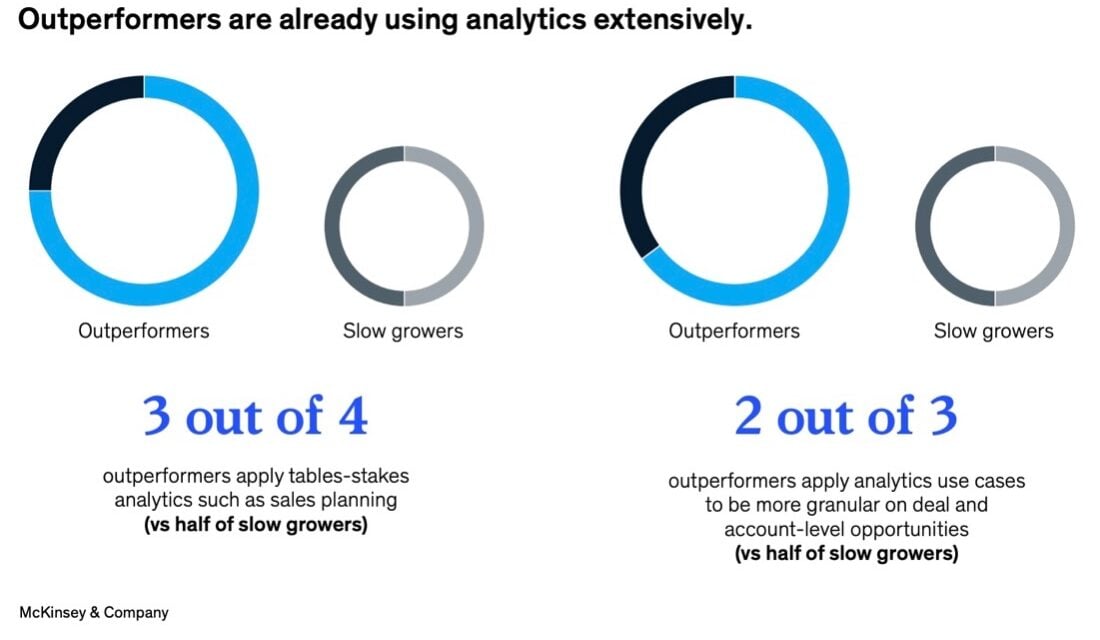For most B2B sales organizations, no matter the economic environment, customer data presents an equally great opportunity and challenge. Without an intentional data strategy that takes you beyond the numbers to a place where real, actionable customer insights live, it can be hard to break out of a data rut, let alone leverage it to fuel predictable, resilient revenue growth.
But a firing-on-all-cylinders data strategy is essential if you want outperforming sellers. A McKinsey & Co. report, How Top Performers Outpace Peers in Sales Productivity, explains it this way: “Leaders further realize that they need to focus on the seller experience. Instead of toggling between systems as many reps are obliged to do today, top-performing organizations integrate customer data and analytics into a single pane of glass, and they work with sellers to ensure account and deal-level insights are presented in user-friendly ways. These efforts have increased seller adoption, which in turn has improved productivity, conversion, and sales.”
To set your organization up for growth in a climate defined by inflation, persistent supply chain issues, and slowing economic growth—realities that Dun & Bradstreet has coined as the “new unknown”—solidifying your data strategy right now is not just wise; it’s a prerequisite.
This is where business intelligence comes in.
Our business intelligence team helps our clients achieve more sales, faster than they thought possible. Put them to work for you.
What Is Business Intelligence?
At its core, business intelligence is a technology-driven process for ingesting and analyzing data to deliver actionable insights to stakeholders that can inform their business decisions.
At MarketSource, supported by revenue acceleration-oriented people, processes, and technology, our extensive BI team is charged with creating a comprehensive picture of our clients’ businesses, equipping them to make strategic business decisions. Our business intelligence approach consists of:
[DESIGN: Make words in parentheses different color font than the category, and carry the color consistently for each (I.e., people = purple, technology = orange, etc.)]
- Salesforce Analysts (people, technology), who customize Salesforce instances to suit our clients’ environments, achieve their KPIs, and capture the best data
- Geographical Information System (GIS) Analysts (people, technology), who analyze location data to offer strategic insights that help clients visualize and understand the market, customer behavior, and the competition, determine where to grow their business, and visualize and manage operations
- Instructional Designers (people, processes), who create and deliver training playbooks to ensure alignment on proper data collection from sales teams
- Business Process Engineers (people, processes), who map the client’s processes to relevant data
- Business Analysts (people, technology), who assess and analyze the data and monitor and measure results that inform sales optimization strategies
- Extensive Sales Enablement Technology Stack (processes, technology). For us, sales technology is not merely an enabler but a foundation, integral to our effectiveness, efficiency, and optimization. We select and align the very best technologies for each client’s needs, placing the right technologies in the right place in the sales process to make every sales rep as productive and efficient as possible.
Each of these elements contributes to our successful, holistic business intelligence approach, allowing us to do more than just collect and regurgitate data. We go beyond reporting to tell a story—a comprehensive, optimal, actionable story that helps our clients understand where and how to increase revenue, improve sales efficiencies, and outperform the competition.
We do this by delivering near real-time data and producing engaging and meaningful dashboards and reports, which empower our clients with data views that allow them to make both macro- and micro-level decisions.
We don’t just synthesize data and report; we tell a story.”
– Ryan Palmore, Director of Reporting and Analytics for MarketSource
Why Business Intelligence Matters
According to Dun & Bradstreet’s 9th Annual Sales & Marketing Data Report, “B2B organizations that are able to adapt to rapidly growing customer expectations by embracing enhanced data and technology capabilities can emerge stronger.”
What does that look like? Leveraging B2B customer data drives profits and growth by:
- Giving you a unified, unbiased, accurate view of your customers’ health
- Providing context to engage effectively with customers across their journey
- Delivering insights to reduce customer churn
- Helping sales managers identify opportunities at the customer level for new product sales or higher margins, which can lead to greater renewal rates
- Empowering you to uncover and diagnose customer journey and sales process inefficiencies
- Reducing sellers’ administrative time
- Equipping sales reps to have successful negotiations
- Helping you drive profitable sales and generate sustained performance
- Identifying growth opportunities
- Pinpointing which levers of the business to adjust and optimize, which can foster resilience during uncertain times
Says Tech Target, “Without BI, organizations can’t readily take advantage of data-driven decision-making. Instead, executives and workers are primarily left to base important business decisions on other factors, such as accumulated knowledge, previous experiences, intuition and gut feelings. While those methods can result in good decisions, they’re also fraught with the potential for errors and missteps because of the lack of data underpinning them.”
BI can help B2B revenue leaders:
|
|
|
|
|
|
|
|
As the authors of the Harvard Business Review article, Leveraging Growth Analytics for B2B, wisely point out, “The amount of data available for decision making and performance monitoring is growing constantly. The same is true for the potency of analytics and artificial intelligence. But not all companies are taking full advantage of data and analytics to drive growth.”
Effective BI Tools Need Reliable Data
Like any decision-informing process worth its salt, effective business intelligence depends heavily upon reliable data. We capture data for our clients through Salesforce, customized for each clients’ environment and needs. We’re able to analyze and glean information on every aspect of the sales function, including operations, performance to KPIs, performance of technology, to customer insights.
We then round out the picture by layering in data from our market research and geographic information system (GIS) teams, who generate both market performance, potential, and opportunity insights.
Once we ascertain the 360° view of the client’s business, we assemble and synthesize the data to create a profile of the client’s entire story. We then build meaningful dashboards around that story so they—and we—can examine it from all angles. Based on the data, we can make minor tweaks to our processes or technology or make a significant pivot in response to changing market conditions.
5 Strategies to Turn 360-Degree B2B Customer Insights into Sales
Whether you outsource your business intelligence or handle it in house, keep in mind that revenue leaders need much deeper insights than one-off queries or reports provide. Make sure your business intelligence team takes a 360° view of all the data impacting your sales performance, from sales processes and technology, to operations, to customer data.
“The amount of data available for decision making and performance monitoring is growing constantly. The same is true for the potency of analytics and artificial intelligence. But not all companies are taking full advantage of data and analytics to drive growth.” – Harvard Business Review
And remember that the data you receive is only as valuable as it is relevant. Your business intelligence team should be able to drive better outcomes by continuously analyzing data and delivering actionable reporting solutions and be supported by large-scale analytics and data warehouse solutions.
To optimize the benefits of business intelligence, follow these five strategies:
- Seamlessly embed analytics tools into your day-to-day sales processes. Only 21 percent of companies McKinsey studied systematically embed insights from analytics into the tools sellers use every day. This leads to suboptimal adoption and incomplete feedback—as well as slow improvement—for analytics models. Making analytics inherent to your sales processes will allow you to quickly act on insights and recommendations.
- Ensure you are relying on both descriptive and predictive data strategies and tools. Past and future perspectives are essential to charting a strategic path forward that enables resilient revenue growth. Make sure your BI team is addressing both to paint a complete picture.
- Identify areas where data and analytics can make the biggest difference. Whether related to new market opportunities, seller optimization, or overcoming stubborn challenges to customer adoption, BI teams need to know your sales goals and priorities in order to deliver relevant insights.
- Manage your sales team and performance based upon data, not subjective experience or intuition. While observations can be helpful in coaching your sellers, data is reliably scrutable and allows you to pinpoint sellers’ specific areas of weakness so you can remedy them without incurring unnecessary turnover.
- Act on what your data tells you. Don’t let your BI team’s findings and recommendations be in vain. Weigh their guidance against what works best for your business and has the greatest opportunity to drive revenue and deliver ROI and make plans to implement.
Says McKinsey, “While forward-thinking companies are using analytical insights to find new customers, others are struggling to adapt to the current digital-first engagement model, which has shifted the power from seller to customer. Customers are doing their own research online and finding out about a company or product before the seller has an opportunity to pitch it, whether it concerns transactional items or complex systems. Companies are therefore turning to analytics to help them predict more accurately who their potential customers are, their pain points and their next moves, and then proactively engage with them as early as possible. Outperformers—here defined as companies that beat the average growth rate of their sector—already use analytics extensively and successfully. Players with strong customer analytics are 1.5 times more likely to grow fast and can drive increases in earnings upwards of 15–25 percent.”
You can become on of them.

Ready to talk?


